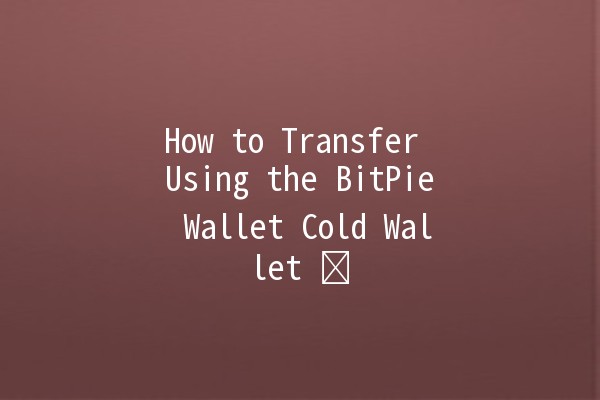
In the world of cryptocurrency, ensuring the safety and proper transfer of your assets is crucial. One of the most secure ways to manage your digital currencies is through cold wallets like the BitPie Wallet. This article will delve deep into the process of transferring your assets from BitPie Wallet’s cold storage, providing practical tips and techniques to enhance your productivity and efficiency during these transfers.
Understanding BitPie Wallet and Cold Wallets
BitPie Wallet signifies a wellregarded digital wallet for managing cryptocurrencies, supporting a wide variety of assets and standing out due to its userfriendly interface. Its cold wallet feature adds another layer of security by keeping your cryptocurrencies offline, away from potential online threats.
What is a Cold Wallet?
A cold wallet is a cryptocurrency storage mechanism that is not connected to the internet. This form of wallet is widely regarded as the safest means of storing digital assets since it is less susceptible to hacking attempts or online fraud. Cold wallets can either be hardware devices or paper wallets, and they facilitate secure longterm storage for your cryptocurrencies.
The Importance of Cold Wallet Transfers
The transfer of cryptocurrencies from cold wallets like BitPie involves carefully managing the security of your assets throughout the process. Here are essential reasons why knowing how to execute transfers is beneficial:

ProductivityEnhancing Tips for Cold Wallet Transfers
To streamline your transfer operations from a cold wallet to another location, consider the following productivityenhancing techniques:
Before initiating a transfer, develop a checklist that includes all necessary steps, such as:
Verify wallet addresses
Confirm available balance
Set transaction fees
Doublecheck private keys (if applicable)
Application Example: A checklist ensures that every critical step is followed, reducing the likelihood of errors that could lead to loss of assets.
When performing any cryptocurrency transfer, ensure you are using a secure and private internet connection. Avoid public WiFi networks to decrease the risk of hacking.
Application Example: Use a VPN service to encrypt your internet connection, further protecting your data during transfers.
If your BitPie Wallet or any associated online accounts allow for it, always enable twofactor authentication. This adds an extra layer of security.
Application Example: When accessing your wallet to perform a transfer, the 2FA requirement can deter unauthorized access.
Maintaining uptodate wallet software and security features is essential. This includes the BitPie Wallet and your device’s operating system. Updates often contain security patches essential to safeguarding your assets.
Application Example: Regularly check for updates in your wallet app and install them promptly, which may prevent vulnerabilities that hackers can exploit.
Familiarize yourself with how transaction fees work on the blockchain. Since these fees can vary significantly based on network activity, knowing when to transfer can save you money.
Application Example: Setting transfer transactions during offpeak hours can result in lower fees, thus preserving your asset's value.
Steps to Transfer from BitPie Cold Wallet
Step 1: Prepare Your Wallet
Ensure that your BitPie Wallet is correctly set up and that you can access your cold wallet information. Your wallet should have sufficient funds for the intended transfer.
Step 2: Retrieve Your Receiving Address
Step 3: Initiate the Transfer
Step 4: Enter the Details
Paste the Receiving Address: Enter the copied address in the appropriate field.
Input Amount: Specify how much cryptocurrency you wish to send.
Set Transaction Fees: Choose the fee that aligns with your urgency for the transfer.
Step 5: Confirm and Send
Review all details thoroughly, and ensure everything appears accurate before clicking 'Send'. A confirmation prompt may follow.
Step 6: Monitor the Transaction
After initiating the transfer, you can use a block explorer to track its status. This is beneficial for confirming that your asset arrived at the target wallet.
Common Questions About BitPie Cold Wallet Transfers
Sending assets to an incorrect address usually results in the permanent loss of your cryptocurrency. Always doublecheck the address and consider sending a small test transaction first.
The BitPie Wallet is known for its security features, including cold storage options and encryption. Utilizing twofactor authentication also significantly boosts protection.
Recovery of a wallet often depends on the backup process in place before losing access. Utilizing recovery phrases or backup files is key to retrieving access.
BitPie Wallet may impose limits depending on the method of transfer or the network conditions. Always refer to updated guidelines on the platform to check for any restrictions.
Yes, cryptocurrency transaction fees fluctuate based on network congestion. Observing network activity can guide you to determine optimal times for transferring funds and minimizing costs.
Typically, transfers can take anywhere from a few minutes to an hour or more, depending on network conditions. Blockchain confirmations can be sought on block explorers to check status.
Managing and transferring your cryptocurrencies from a cold wallet is an essential skill for participants in the digital economy. By understanding the basic principles of cold wallets, implementing enhanced productivity techniques, and following proper procedures, you can ensure your assets remain secure while enjoying hasslefree transactions. The BitPie Wallet remains a viable option for users seeking an efficient, secure, and flexible cryptocurrency management tool.

